Qatar LIVE Population Count
7,500,710
Qatar is a small country in the Middle East, with an area of approximately 11,610 sq km.
It sits next to Saudi Arabia and is surrounded by the Persian Gulf on three sides.
Despite its small size, the country offers numerous job opportunities in sectors such as petroleum and energy, science, technology, hospitality, and construction.
Due to this and its high standard of living, many people from other countries come to live and work in Qatar.
This has a significant impact on the overall population and demographics of the country today.
In this article, we will explore Qatar’s 2024 population statistics.
We will learn about the total population of Qatar in 2024, the number of expatriates and natives in the region, gender distribution, and population growth over the last decade, among other things.
Key Population Statistics of Qatar 2024
The population of Qatar stands at 3.12 million.
The population density in Qatar is 234 persons per square km.
The median age is 33.8 years.
The male population is 2.4 million and the female population is 0.72 million.
The population of the age group 25-54 is the highest, consisting of 2.18 million.
The non-Qatari population is 2.76 million while the Qatari population is 0.36 million.
Muslims form the majority group in Qatar with 2.034 million people.
Doha is the most populated city in Qatar with 47.65% of the population residing there.
Qatar Population Statistics 2024 [Infographics]

Population According to Different Sources
Qatar Government Website | 3.12 Million |
Statista | 2.90 Million |
Worldometers.info | 2.73 Million |
Worldpopulationreview.com | 2.73 Million |
Populationpyramid.net | 2.73 Million |
The world Factbook | 2.53 Million |
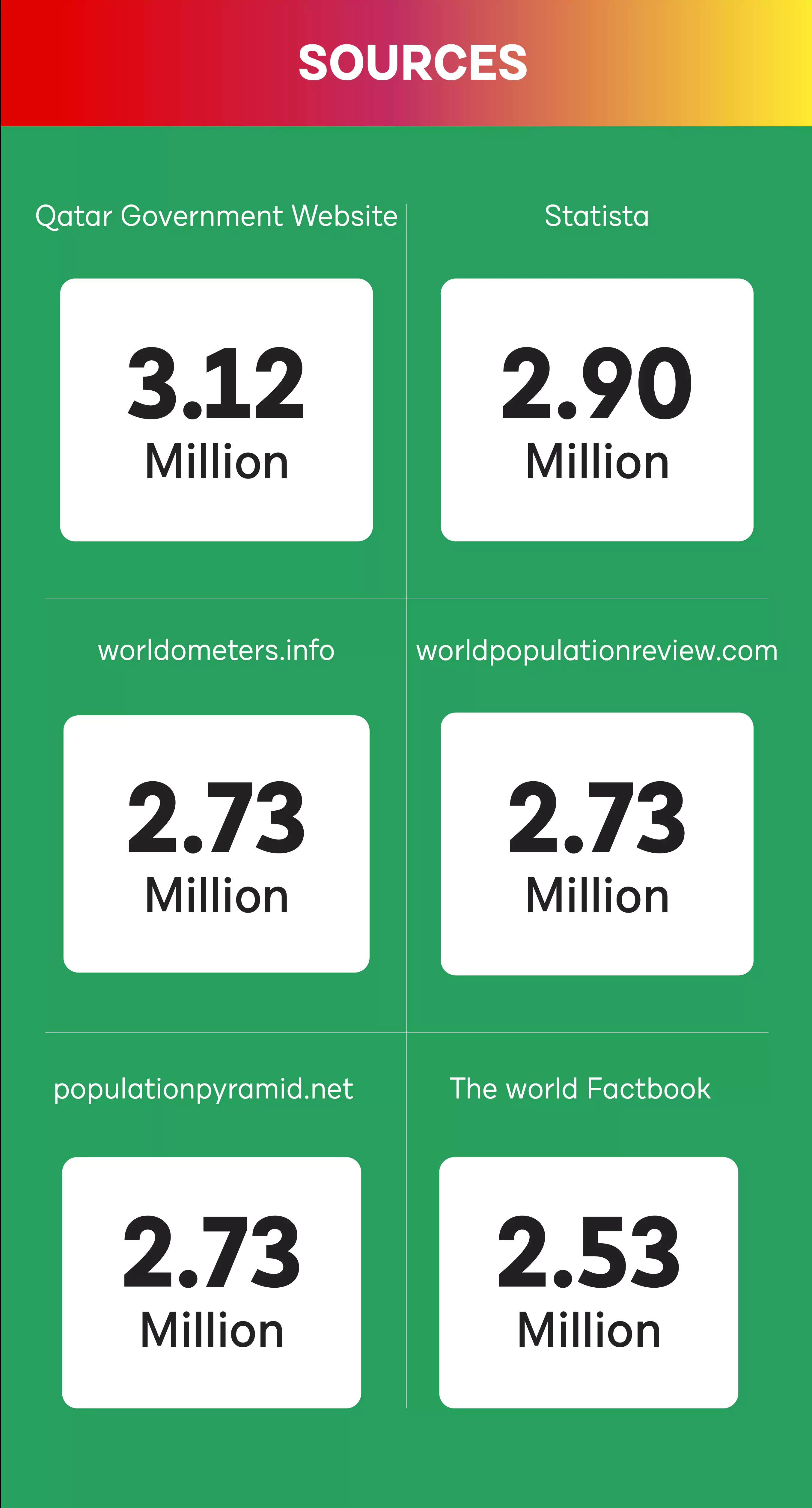
When considering Qatar’s total population in 2024, various sources present slightly different figures.
The country’s official website reports a population of 3.12 million.
Other sources, such as Statista, state it as 2.90 million, while Worldometers.info, Worldpopulationreview.com, and Populationpyramid.net indicate a population of 2.73 million.
The World Factbook, however, provides a slightly lower figure at 2.53 million.
General Information
Population Density | 234 per Km2 |
Median Age | 33.8 Years |
Total Land Area | 11,610 Km2 |
Capital City | Doha |
Official Language | Arabic |
Qatar is a peninsula surrounded by water on three sides, mostly covered in flat desert with loose sand and gravel.
Surprisingly, some areas near the eastern coast have greenery like trees and shrubs.
In the west, there are hills called ‘jebels,’ and the coastline is about 700 kms long.
Arabic is the official language, and Doha is the capital.
The population density is 234 people per sq km, and the median age is 33.8 years.
Demographics of Qatar in 2024
While analyzing the demographics of Qatar in 2024, we came across many interesting facts that can help us understand the region better.
Let us explore it in detail.
Gender Split
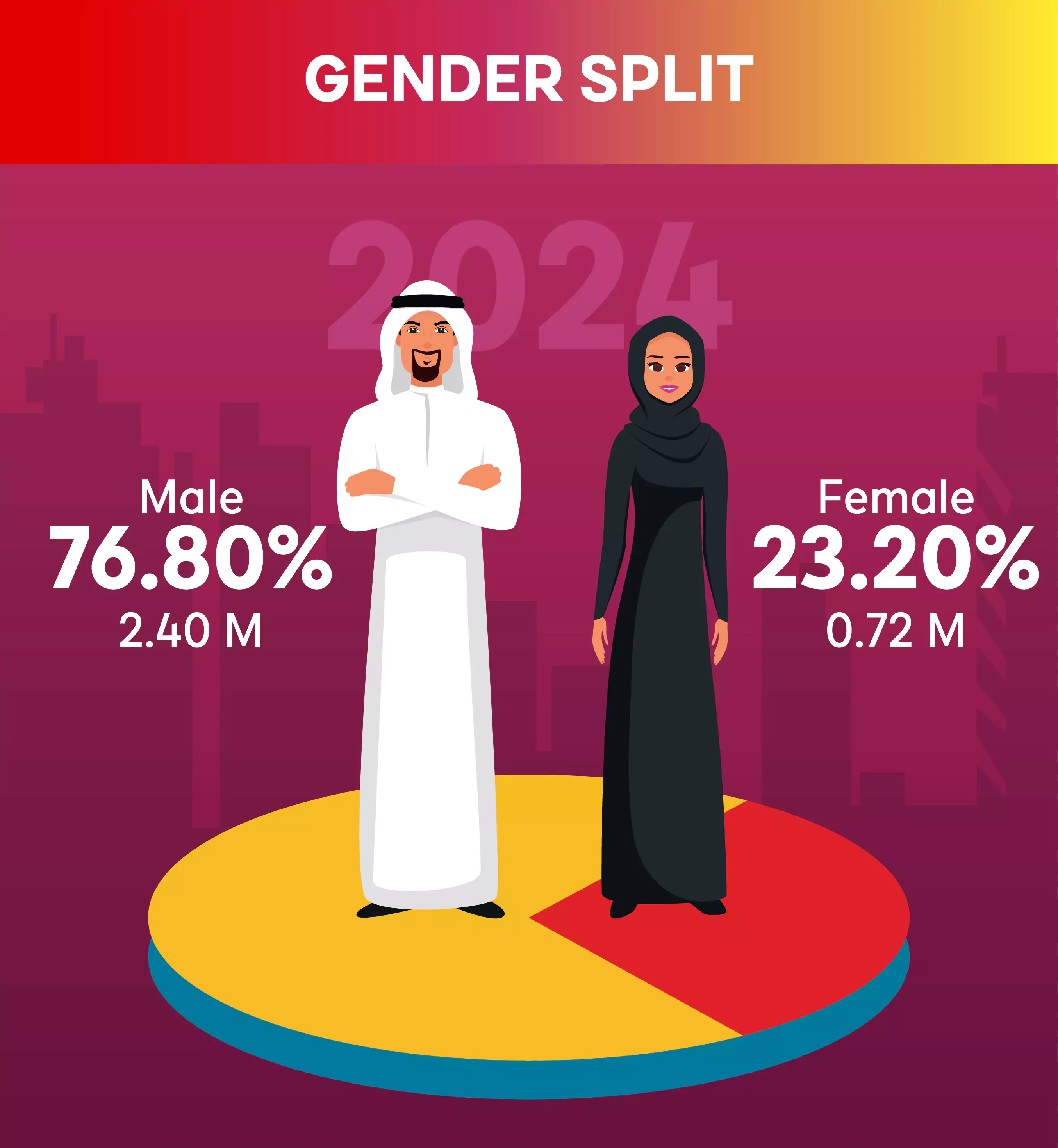
Gender distribution in Qatar reveals a predominance of males, constituting approximately 76.80% of the population, which equates to around 2.4 million individuals.
Females account for the remaining 23.20%, comprising approximately 0.72 million people.
The large male population can be indicative of the expatriate workforce who come without their families.
This demographic composition shapes various aspects of Qatari society, influencing social dynamics, workforce participation, and cultural norms.
Gender | Percentage | Population |
Male | 76.80% | 2.40 Million |
Female | 23.20% | 0.72 Million |
Qatar Population By Age
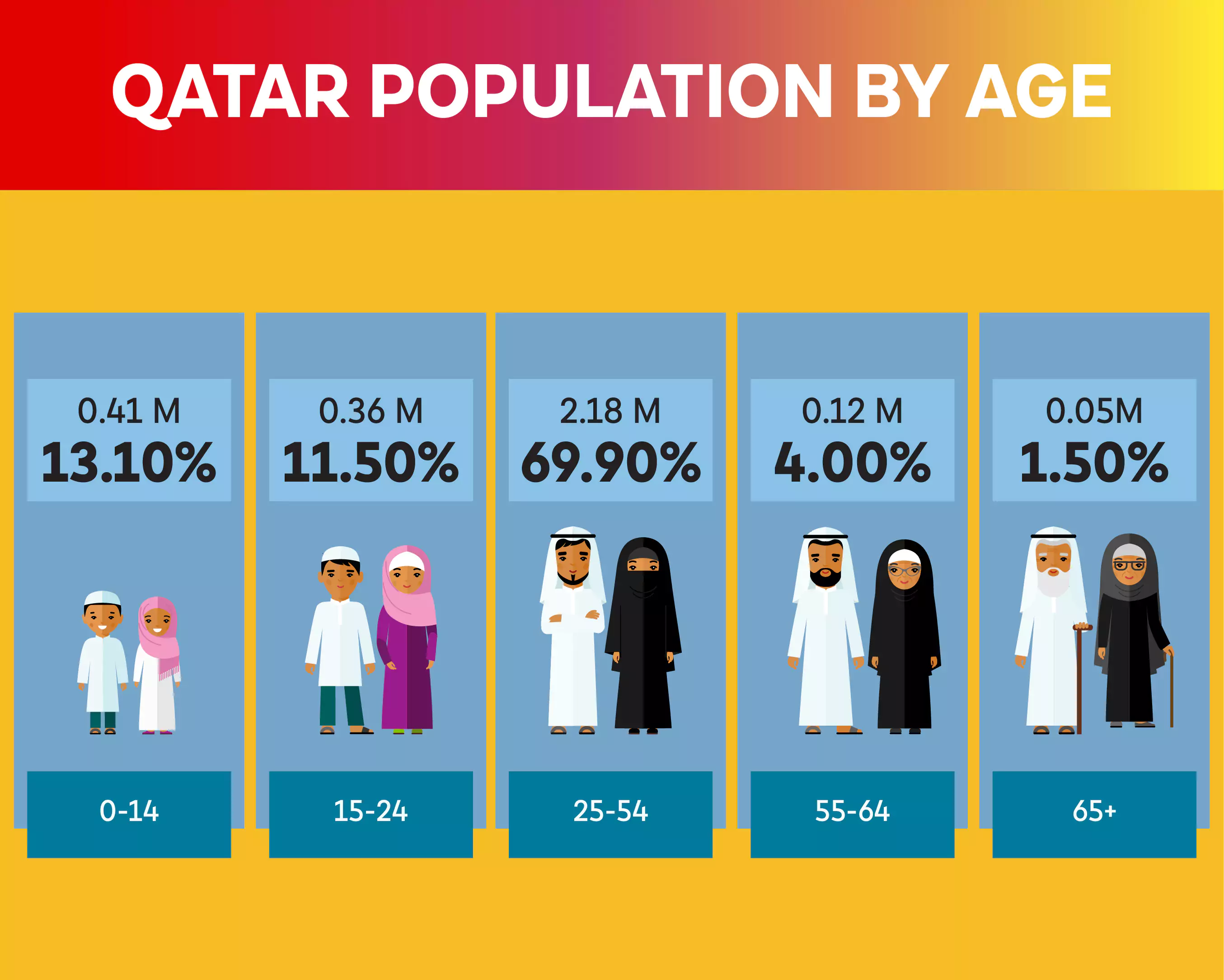
The population of Qatar exhibits a diverse age distribution, with the majority falling within the 25-54 age group, constituting approximately 69.9% of the population, equivalent to 2.18 million individuals.
Younger demographics are represented by the 0-14 age group, accounting for 13.1% of the population (approximately 0.41 million), and the 15-24 age group, comprising 11.5% (approximately 0.36 million).
Meanwhile, the older segments include the 55-64 age group, making up 4% approximately 0.12 million), and those aged 65 years and over, representing 1.5% (approximately 0.05 million) of the population.
This varied age distribution underscores the diverse societal needs and demographic challenges facing Qatar.
Age Group | Percentage | Population |
0-14 years | 13.10% | 0.41 Million |
15-24 years | 11.50% | 0.36 Million |
25-54 years | 69.90% | 2.18 Million |
55-64 years | 4.00% | 0.12 Million |
65 years and over | 1.50% | 0.05 Million |
Qatar Population By Gender
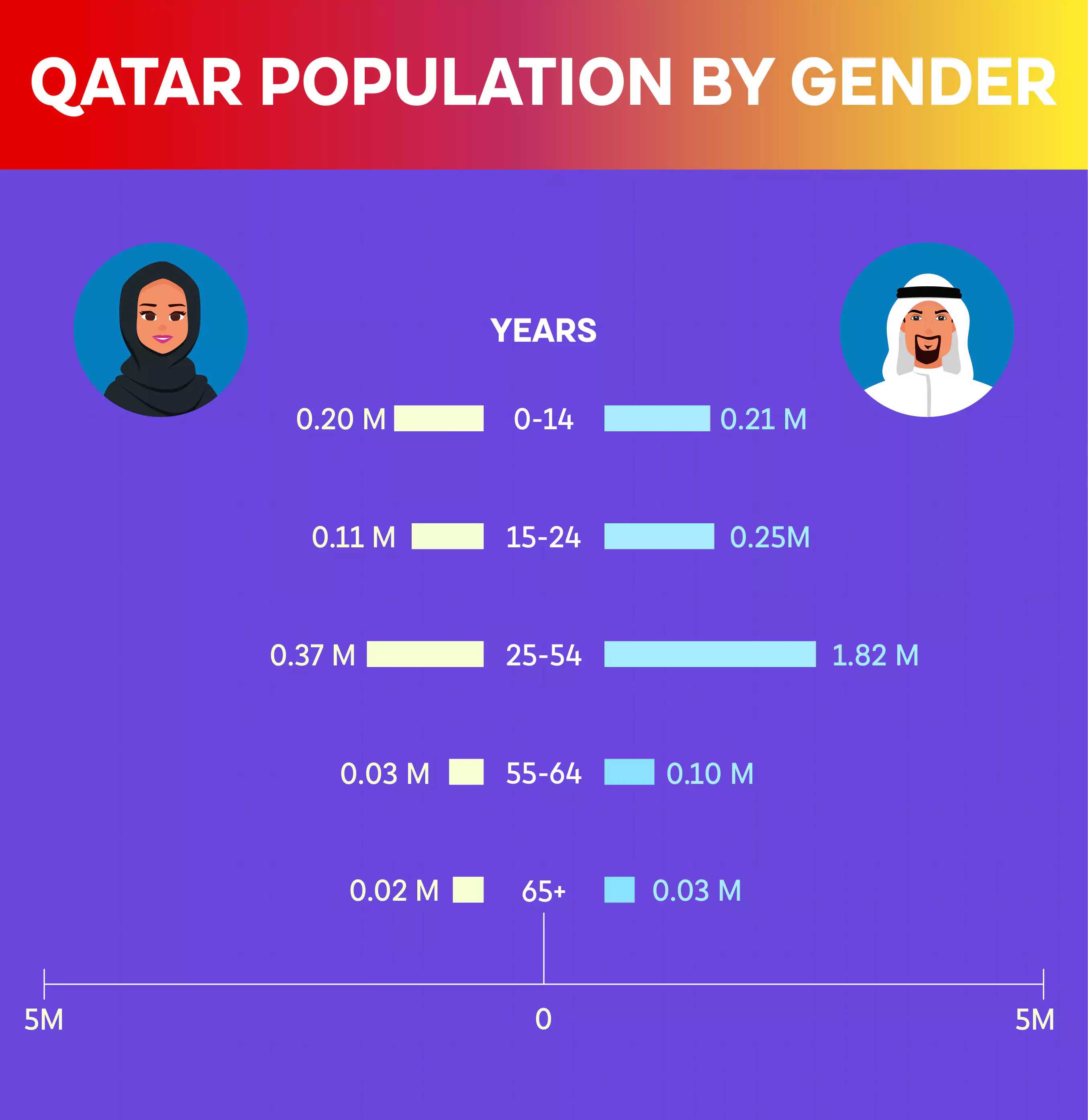
Qatar’s population by gender across different age groups reveals interesting patterns.
In the 0-14 age bracket, there are slightly more males than females, with approximately 0.21 million boys compared to 0.20 million girls.
Similarly, in the 15-24 age group, males outnumber females, with around 0.25 million young men and 0.11 million young women.
However, in the 25-54 age range, the gender distribution is more balanced, with approximately 1.82 million men and 0.37 million women.
Among those aged 55-64, there are approximately 0.10 million men and 0.03 million women, while in the 65 years and over category, there are roughly 0.03 million men and 0.02 million women.
These gender-specific demographic insights not only provide valuable context for understanding Qatar’s population dynamics but also shed light on the societal roles, healthcare needs, and economic participation of different gender groups within the country.
Age Group | Men Population | Women Population |
0-14 years | 0.21 Million | 0.20 Million |
15-24 years | 0.25 Million | 0.11 Million |
25-54 years | 1.82 Million | 0.37 Million |
55-64 years | 0.10 Million | 0.03 Million |
65 years and over | 0.03 Million | 0.02 Million |
Qatari V/S Expatriates
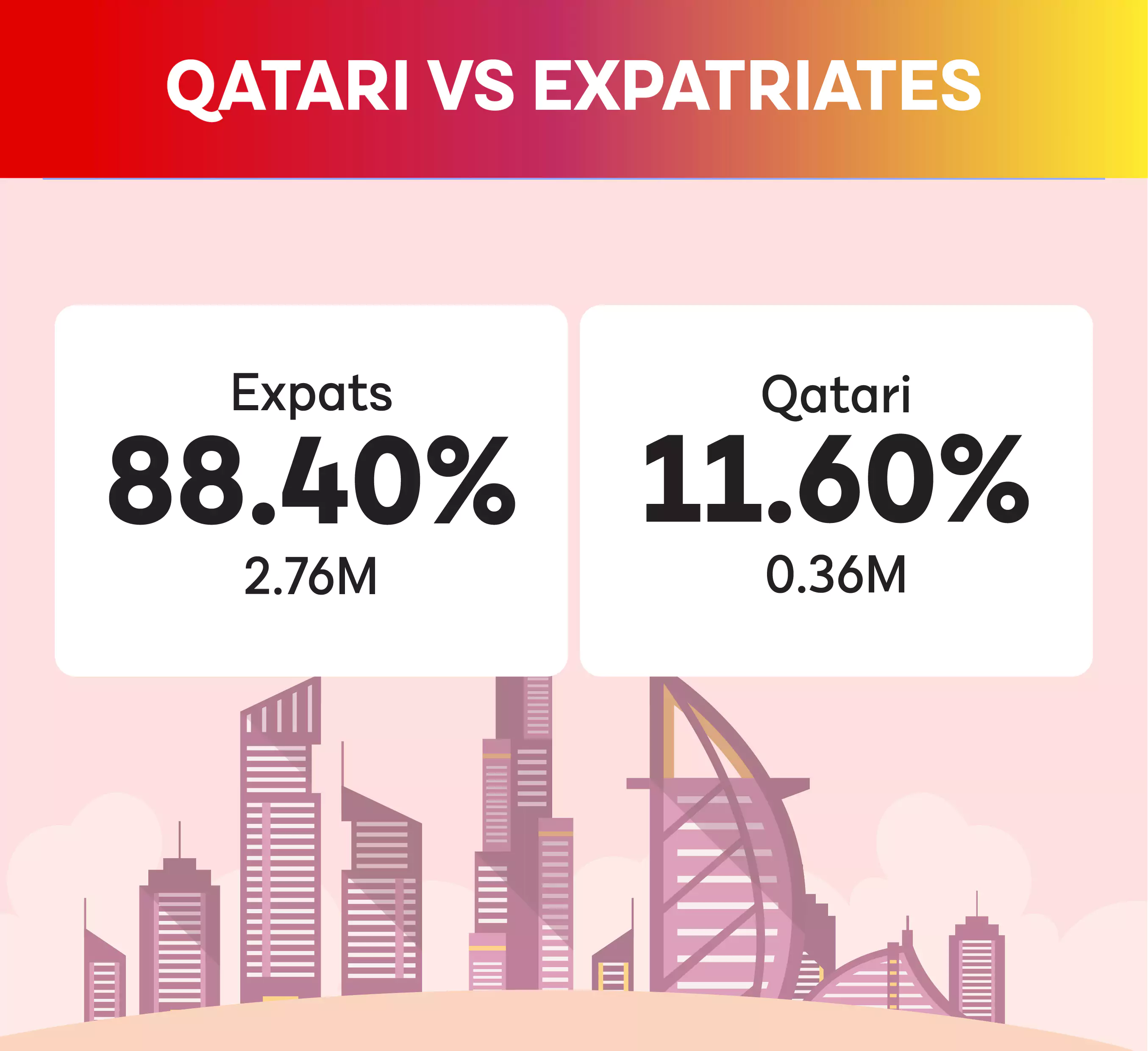
Similar to other Gulf countries, Qatar’s population is characterized by a diverse mix of expatriate communities.
According to the 2024 population report, expatriates constitute the majority, making up approximately 88.4% of the population, equivalent to around 2.76 million people.
In contrast, Qatari nationals represent a smaller proportion, accounting for approximately 11.6% of the population, or about 0.36 million people.
Qatar is actively pursuing its Qatarization initiative, aiming to increase the employment of Qatari citizens in both public and private sectors.
The target is to achieve 50% representation of Qatari citizens in the core sectors.
These efforts align with the Qatar National Vision 2030, and all of this will result in maintaining a more balanced population.
Nationality | Population | Percentage |
Qatari | 0.36 Million | 11.60% |
Expats | 2.76 Million | 88.40% |
Qatar Population By Nationality
As of 2024, the largest expatriate community is Indian, constituting 21.80% of the population, approximately 700,000 people.
Bangladesh and Nepal contribute significantly, each making up 12.50%, equivalent to 400,000 individuals.
Qatar’s own nationals represent only 10.50% of the population.
Egypt, the Philippines, and Pakistan also have notable percentages at 9.35%, 7.36%, and 4.70%, respectively.
Other significant communities include Sri Lanka (4.35%), Sudan (1.90%), Syria (1.80%), Jordan (1.60%), Lebanon, and the United States, each accounting for 1.25%.
Refer to the table for more details.
Country | Population | Percentage |
India | 700000 | 21.80% |
Bangladesh | 400000 | 12.50% |
Nepal | 400000 | 12.50% |
Qatar | 330000 | 10.50% |
Egypt | 300000 | 9.35% |
Philippines | 236000 | 7.36% |
Pakistan | 180000 | 4.70% |
Sri Lanka | 140000 | 4.35% |
Sudan | 60000 | 1.90% |
Syria | 54000 | 1.80% |
Jordan | 51000 | 1.60% |
Lebanon | 40000 | 1.25% |
United States | 40000 | 1.25% |
Kenya | 30000 | 1.00% |
Iran | 30000 | 1.00% |
Qatar Population By Year
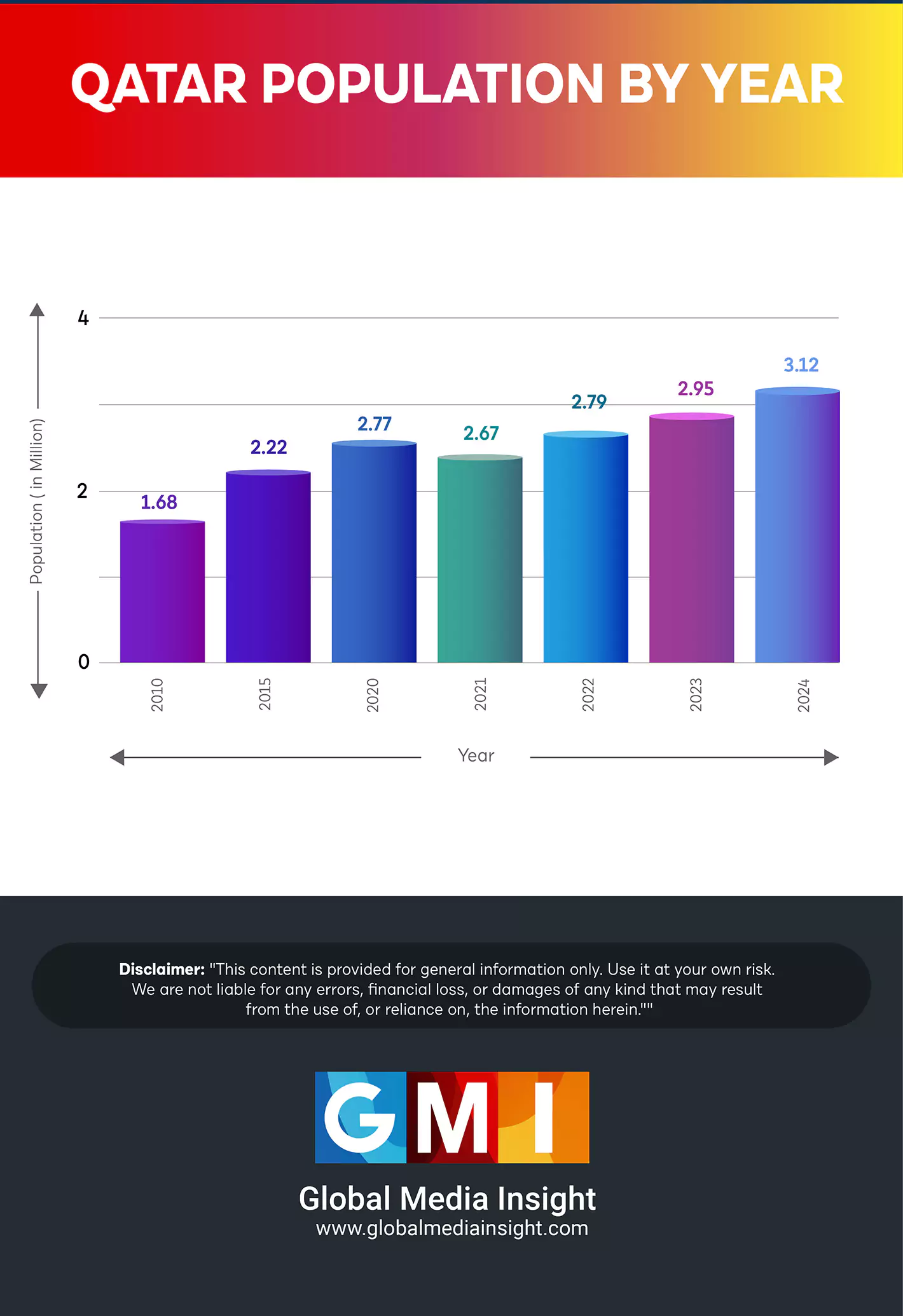
Qatar’s population has steadily grown since 2010, reaching 3.12 million in 2024.
In 2010, the total population was only 1.68 million, but by 2015, it had increased to 2.22 million – an impressive growth of 0.54 million.
Between 2015 and 2020, the population further expanded by 0.55 million.
From 2020 to 2024, the population continued to grow, adding another 0.45 million.
Interestingly, the majority of Qatar’s residents are expatriates.
Year | Population |
2024 | 3.12 Million |
2023 | 2.95 Million |
2022 | 2.79 Million |
2021 | 2.67 Million |
2020 | 2.77 Million |
2015 | 2.22 Million |
2010 | 1.68 Million |
Qatar Population By Religion
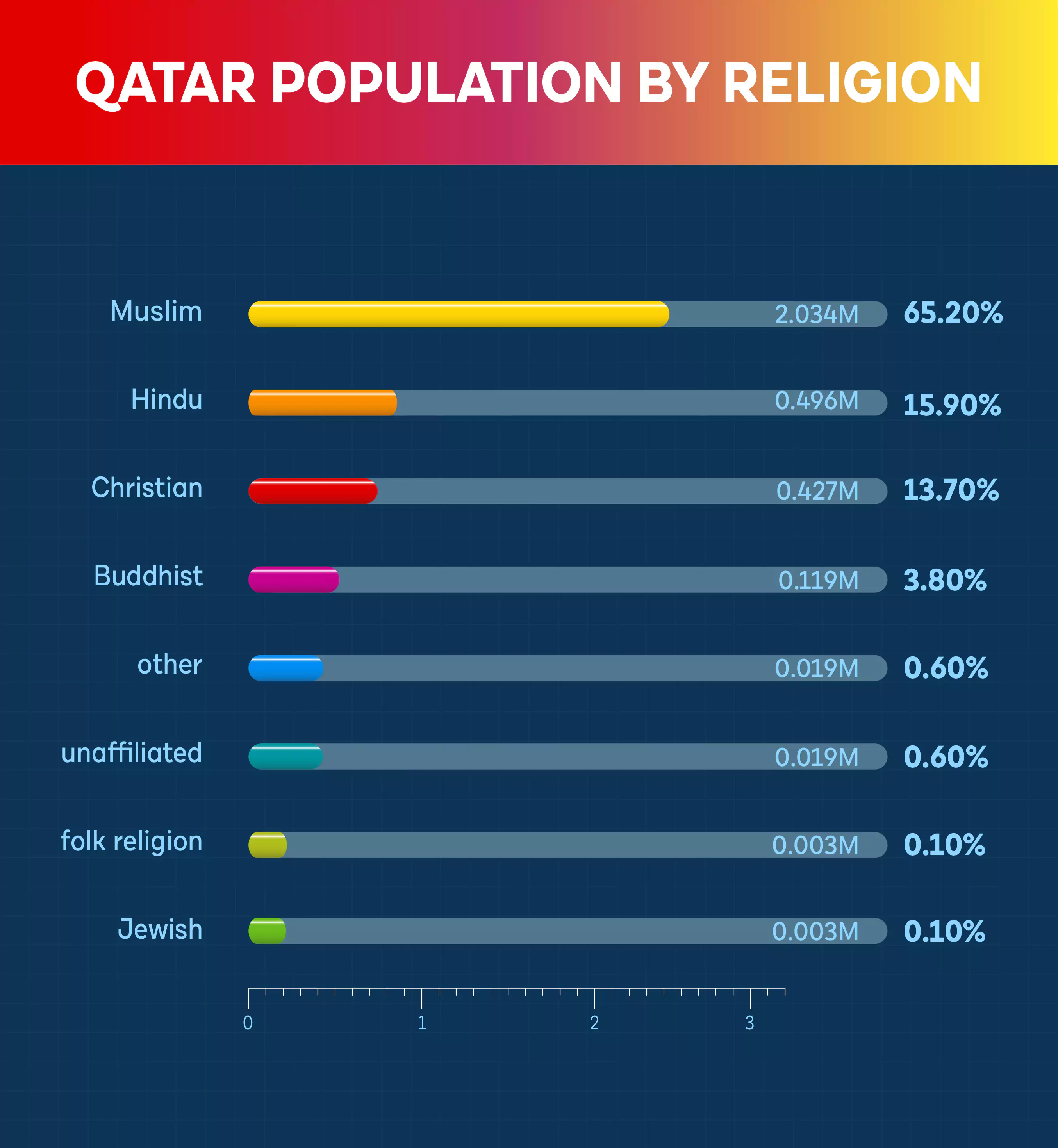
Islam constitutes the majority of Qatar’s population, accounting for 65.20% (approximately 2.034 million people).
Hindus come next, making up 15.90% (around 0.49 million), while Christians comprise 13.70% (approximately 0.42 million).
A smaller percentage, 3.80%, consists of Buddhists. Jews and followers of folk religions each represent 0.10%.
The remaining 1.2% encompasses other religious affiliations and the unaffiliated category.
Religion | Percentage | Population |
Muslim | 65.20% | 2.034 Million |
Hindu | 15.90% | 0.496 Million |
Christian | 13.70% | 0.427 Million |
Buddhist | 3.80% | 0.119 Million |
Other | 0.60% | 0.019 Million |
Unaffiliated | 0.60% | 0.019 Million |
Folk Religion | 0.10% | 0.003 Million |
Jewish | 0.10% | 0.003 Million |
Qatar Population By City
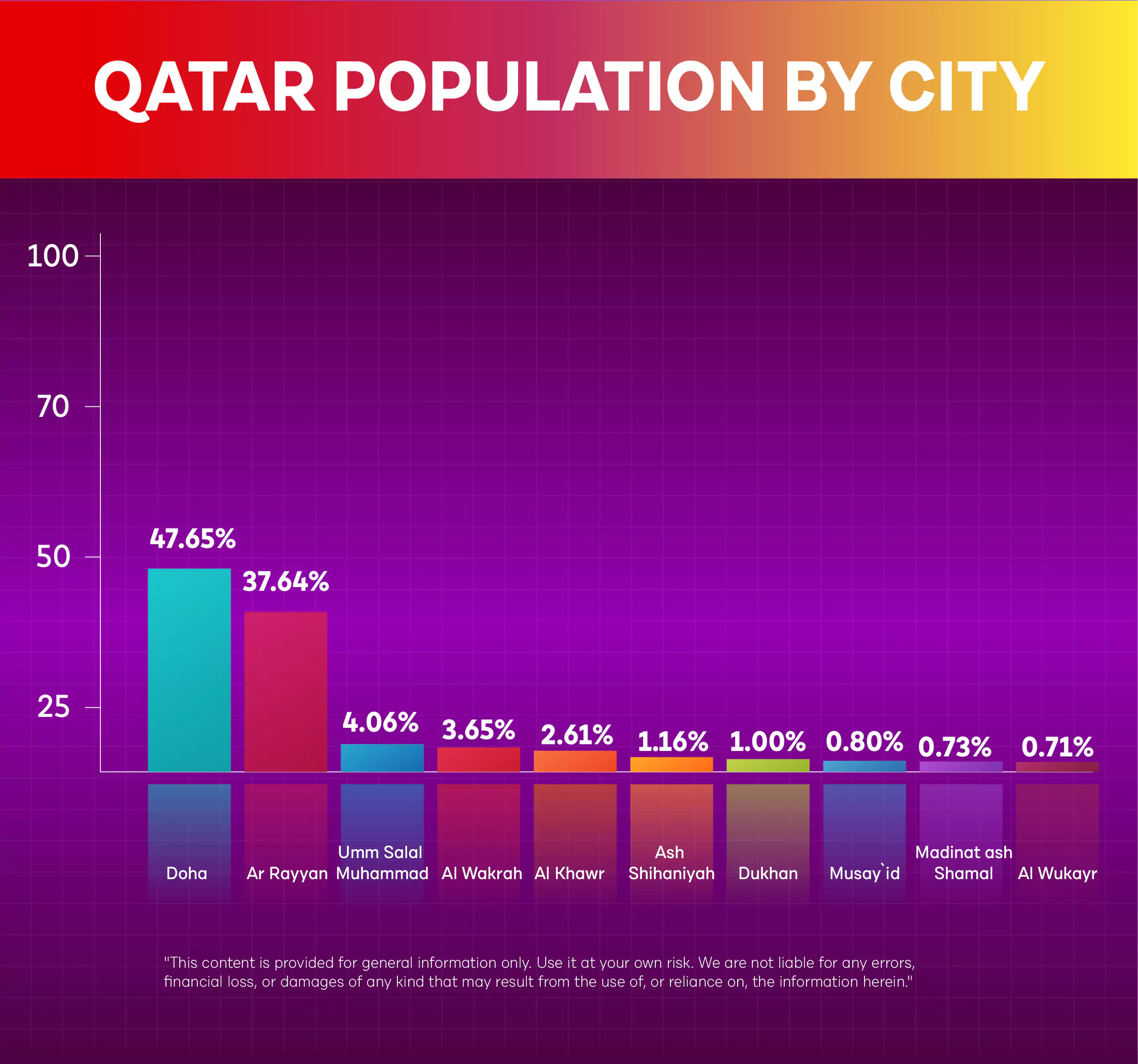
Qatar’s population is unevenly distributed across its cities.
As of the 2024 data, nearly half of the country’s total population (47.65%) resides in its capital city, Doha.
The city of Ar Rayyan closely follows with 37.64%. Meanwhile, eight other cities have populations in the single digits.
Umm Salal Muhammad accounts for 4.06%, Al Wakrah for 3.65%, and Al Khawr for 2.61%.
The remaining population is distributed across cities such as Ash Shihaniyah, Dukhan, Musay’id, Madinat ash Shamal, and Al Wukayr.
City | Percentage |
Doha | 47.65% |
Ar Rayyan | 37.64% |
Umm Salal Muhammad | 4.06% |
Al Wakrah | 3.65% |
Al Khawr | 2.61% |
Ash Shihaniyah | 1.16% |
Dukhan | 1.00% |
Musay`id | 0.80% |
Madinat ash Shamal | 0.73% |
Al Wukayr | 0.71% |
Conclusion
With a population of over 3 million, Qatar stands as a vibrant melting pot of nationalities, with expatriates playing a pivotal role in its development.
As the Qatar government takes steps to reduce these disparities and move ahead in its developmental journey, the dynamics of its population will undoubtedly remain a central focus, driving social, economic, and cultural transformation in the years to come.
Disclaimer: This content is provided for general information only. Use it at your own risk. We are not liable for any errors, financial loss, or damages of any kind that may result from the use of, or reliance on, the information herein









